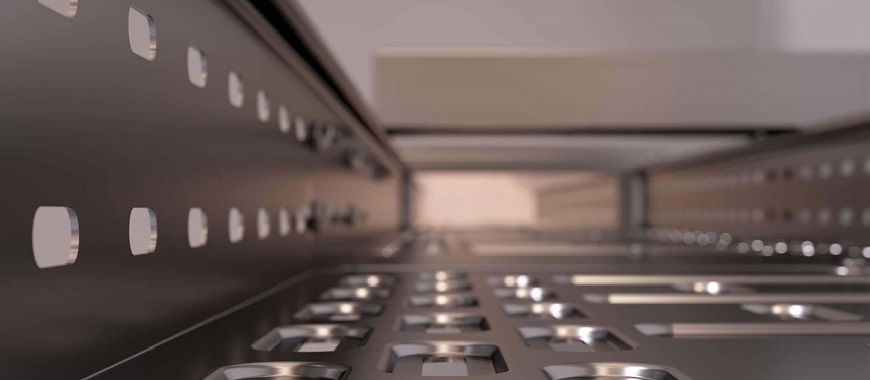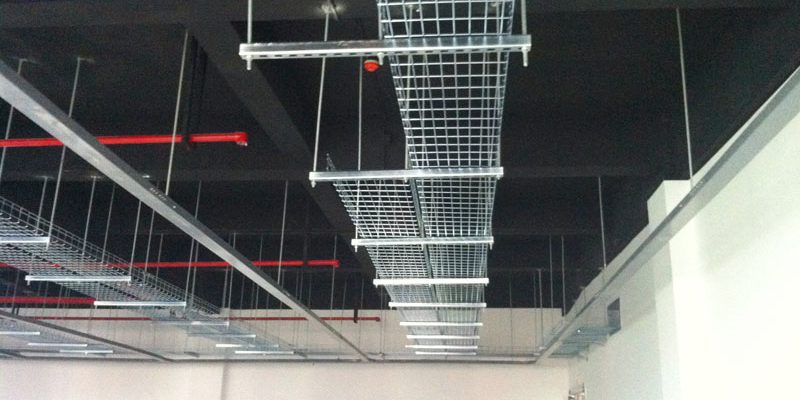
A double layer cable tray is an advanced cable management solution designed to support large and complex cable bundles. By stacking two layers of trays, this system effectively optimizes space while improving the organization and protection of cables. Organize cables easily with a no-drill double layer cable tray, offering adjustable under-desk storage for multiple wires. The importance of double layer cable trays lies in their ability to manage multiple cables, ensuring they are securely organized, reducing clutter, and providing easy access for maintenance. In both commercial and industrial environments, this type of cable tray helps maximize space utilization, enhances cable routing efficiency, and contributes to a safer working environment. By using double layer cable trays, businesses can reduce the risks of cable damage, streamline installations, and ensure optimal system performance.
Double layer cable tray and other types
In cable management, multiple tray types address diverse installation needs. Double layer trays optimize vertical capacity and cable separation, while unitray options offer open, sturdy single-tier support. Multi tier systems further enhance organization by dedicating distinct levels for power and data lines, ensuring efficient, safe wiring in complex environments.
Double Layer Cable Tray
A double layer cable tray features two stacked levels of support, enabling separation of power and data cables within a single system. Constructed from steel or aluminum, these trays offer robust strength and corrosion resistance. The dual-tier design optimizes vertical space, reduces cable congestion, and simplifies organization. Technicians benefit from clear separation and easier troubleshooting, while airflow between layers prevents overheating. Ideal for industrial plants and large commercial installations, double layer trays balance capacity and accessibility.
Unitray Cable Tray
A unitray cable tray is a single-piece, open-top system designed for straightforward cable management. Typically made from steel or aluminum, it delivers high load capacity and corrosion resistance at an affordable price point. The open design permits rapid cable deployment and inspection without disassembly. Unitray systems adapt to various applications—from manufacturing floors to data centers—by accommodating diverse cable types and promoting efficient airflow. Their sturdy construction minimizes maintenance and prolongs service life.
Multi Tier Cable Tray
Multi tier cable trays consist of two or more horizontally stacked trays, each dedicated to specific cable categories. This arrangement maximizes usage of limited overhead or wall space in environments with high cable density. By segregating power cables on one level and communication lines on another, interference is reduced and safety is enhanced. These trays, often fabricated from galvanized steel, ensure easy access for additions or repairs. Multi tier systems are indispensable in data centers and complex industrial facilities.

Essential Tools to Build Cable Trays Safely
Double Layer Cable Tray Sizes
When selecting a double stacked cable tray, it’s essential to choose the right size to accommodate the specific cables being managed. Double layer cable tray sizes vary, with options ranging from narrow trays for smaller cables to larger trays for extensive cable bundles. The choice of size depends on several factors, such as the volume of cables, the type of cables, and the installation environment. For example, power cables may require a wider tray than control cables.
Factors Influencing Size Selection
- Cable Bundle Volume: The more cables, the larger the tray needed.
- Cable Type: Different cables, such as power cables or data cables, have specific requirements for tray size.
- Installation Environment: Tight spaces or high-temperature environments may require adjustments in size for both ventilation and accessibility.
Common Sizes and Their Pros/Cons
- Standard Sizes: Common sizes include 6-inch, 12-inch, and 18-inch trays. Larger trays are ideal for heavy-duty or high-capacity cable installations.
- Pros: Larger trays allow for more cables and future expansion.
- Cons: Larger trays can be bulkier, which might make installation and adjustments more difficult in constrained spaces.
How to Calculate the Appropriate Size
- Calculate the total volume of cables: Consider the diameter and number of cables.
- Determine required clearance: For proper airflow and safety, ensure that cables are not overcrowded.
Double Layer Cable Tray Installation
Installing a double layer cable tray requires careful planning and attention to detail to ensure proper functionality and compliance with safety standards. Here’s a step-by-step guide to installing this system:
Step-by-Step Guide to Installation
Begin by mapping the tray path, avoiding obstructions and ensuring adequate support points along the route. Lay out all double-layer cable tray sections, brackets, splice connectors, and mounting hardware. Install support brackets at regular intervals, level them, and attach the lower tier first. Secure the upper tier brackets afterward. Finally, join tray sections with splice connectors and tighten fasteners to maintain alignment and stability.
Tools and Materials Required
Gather adjustable wrenches, screwdrivers, a tape measure, level, and cable-tying tools before starting. Materials include double-layer tray sections, mounting brackets, splice connectors, threaded rods or wall anchors, and cable supports. Have anti-vibration pads or insulating inserts on hand if required. Confirm that all hardware—bolts, nuts, and washers—matches tray manufacturer specifications to guarantee a secure, code-compliant installation without last-minute trips for missing parts.
Proper Spacing and Clearance
Maintain adequate spacing between tray layers and adjacent structures for airflow and heat dissipation. Follow NEC guidelines: typically, 1 inch of vertical clearance per ampere per conductor bundle size. Leave enough room above the upper tier for future cable additions. Ensure side and bottom clearances align with mechanical equipment and fire-rating requirements. Proper clearance prevents overheating, simplifies ventilation, and grants unobstructed access for inspection and maintenance.
Securing the Tray System
Anchor the tray to support beams or walls using approved brackets and hardware at intervals specified by the manufacturer. Ensure the assembly is rigid, level, and free of sway. Use lock washers or nylon-insert nuts to prevent loosening under vibration. Install cable supports every five feet, and secure cables with ties rated for the environment. Validate that the installation resists mechanical stress and meets seismic or vibration standards where applicable.
Adhering to Electrical Codes
Compliance with NEC and local codes is essential. Double-layer trays naturally segregate power and data cables, reducing electromagnetic interference and meeting separation requirements. Verify grounding and bonding connections per Section 392 of the NEC. Ensure fire-stop systems are installed where trays penetrate walls or floors. Document the installation, noting tray load ratings and cable types, to simplify future inspections and maintain a safe, code-compliant cable management system.

Split HVAC Unit Mounted Cable Tray Installation Guide
Cable Tray Under Desk: Advantages of double layer cable tray
Advantages of double layer cable trays include space optimization, enhanced organization, and simplified maintenance. By routing power and data cables on separate tiers, they prevent tangling and reduce clutter. This clear separation makes tracing and replacing individual lines quick and easy. Their robust construction supports future expansions and keeps workstations neat and professional.
Space-Saving and Aesthetic Under-Desk Solutions
Installing a double layer cable tray beneath a desk maximizes workspace by lifting cables out of the way and using vertical space efficiently. This eliminates visible wires hanging below, creating a tidy, professional look. By concealing bundles and reducing floor clutter, the tray maintains a clean environment that enhances office aesthetics and prevents trip hazards without sacrificing desk legroom or workspace openness.
Enhanced Organization and Accessibility
The tray’s two-tier design separates power and data cables, preventing tangles and simplifying identification. Placing high-voltage cords on one layer and peripherals on the other streamlines cable routing and upkeep. Open-top access allows technicians to quickly trace, replace, or reconfigure individual lines without dismantling entire runs. This organization minimizes downtime during maintenance and ensures a reliable, easy-to-service cable infrastructure.
Integrated Functionality and Future-Proofing
A double layer under-desk tray accommodates multiple cable types—power, USB, Ethernet, audio—within a single framework, supporting current and future connectivity needs. Its modular sections adapt to evolving office setups, so new devices can be added without creating chaos. As technology changes, the tray’s expandable capacity handles additional lines seamlessly, keeping workstations adaptable, clutter-free, and ready for upgrades without invasive rewiring.
Durability, Longevity, and Cost Savings
Constructed from robust materials like steel or reinforced aluminum, double layer trays resist wear, corrosion, and deformation under weight. Their long service life reduces the need for replacements, delivering significant savings over time. Fewer repairs and straightforward maintenance cut labor costs, while protected cables experience less damage. Overall, this dependable system delivers a high return on investment by minimizing downtime and extending equipment lifespan.
Improved Energy Efficiency
By organizing cables into a well-ventilated, off-surface channel, double layer trays enhance airflow around power supplies and network equipment. Reduced cable congestion prevents heat buildup, helping devices run cooler and more efficiently. Improved cooling lowers energy consumption and extends equipment life. In aggregate, better thermal management contributes to lower utility costs and supports a greener, more sustainable workspace environment.
Double Layer Cable Tray Electrical Standards and Codes
Ensuring compliance with the cable tray electrical code in the National Electrical Code (NEC) is vital when installing cable tray systems. NEC Article 392 defines requirements for tray construction, support spans, clearance, grounding, and bonding to guarantee mechanical integrity, proper cable separation, and fire prevention. Adhering to these standards maximizes safety, reliability, and efficiency.
NEC and Installation Standards
The National Electrical Code (NEC) provides comprehensive guidelines for safe, reliable cable tray installations in the United States. It defines requirements for tray construction, support intervals, and material ratings to ensure mechanical integrity under load. Installers must reference NEC Article 392, which covers permissible tray materials, fill capacities, and environmental conditions. Adherence to these standards prevents overloading, supports predictable performance, and reduces safety risks during operation.
Clearance and Spacing Requirements
NEC mandates specific clearances between cable trays and surrounding structures to allow heat dissipation and maintenance access. Vertical and horizontal spacing depends on cable types, tray fill, and environmental classification (wet, damp, or dry). In-tray cable separation minimizes electromagnetic interference and prevents thermal damage. Proper clearance accommodates thermal expansion and system vibrations, ensuring that adjacent equipment and cables remain unaffected, while facilitating inspections and emergency interventions.
Grounding and Bonding Requirements
Grounding and bonding of cable trays are essential for electrical safety. NEC requires trays to be electrically continuous and connected to the building’s grounding system, creating a low-impedance path for fault currents. Bonding jumpers ensure all metal components share the same potential, preventing shock hazards. Installers must attach grounding conductors per manufacturer specifications and verify continuity across joints, brackets, and splice connectors to maintain compliance and protect both personnel and equipment.
Double Layer Cable Trays: Enhancing Safety and Protection
A double layer cable tray system stacks two independent trays, separating power and low-voltage cables to meet NEC segregation rules. This configuration reduces electromagnetic interference and shields lower-tier cables from physical damage. The upper tier acts as a protective barrier against impact or moisture, while dedicated spacing between layers ensures adequate airflow. By combining separation, protection, and organized routing, double layer trays improve overall system reliability and simplify future upgrades.
Advantages of Compliance with NEC Code
Following NEC guidelines for cable tray installations ensures safety, legal compliance, and operational efficiency. Proper clearances, bonding, and material selection reduce fire, shock, and equipment-failure risks. Compliance streamlines inspection approvals and satisfies insurance requirements, avoiding costly penalties or project delays. Installations built to code demonstrate professional quality, minimize maintenance issues, and extend system lifespan. Ultimately, NEC adherence protects both assets and personnel, offering peace of mind for facility owners and managers.

Cable Tray Blind End Plate: Key Features and Benefits
FAQs about Double Layer Cable Tray
Yes, cable trays can be stacked, but there are certain considerations to ensure safe and effective installation. Stacking cable trays is a common practice, especially when managing large volumes of cables or when space constraints require the use of vertical space. However, when stacking cable trays, it is crucial to follow specific installation guidelines to maintain safety and accessibility. The stacked trays should be properly supported at both ends and along their length to prevent sagging or instability. It is also important to ensure adequate clearance between the trays for proper airflow, which helps prevent overheating of the cables inside. Additionally, when stacking trays, make sure that the cables are correctly organized and separated to avoid interference and to comply with electrical codes such as the NEC (National Electrical Code). By following these guidelines, you can safely stack cable trays for improved cable management.
There are three primary types of cable trays used in cable management systems: ladder cable trays, wire mesh cable trays, and solid-bottom (or enclosed) cable trays. Each type has distinct features that make it suitable for specific applications.
Ladder Cable Trays: This type of tray is known for its open design that looks like a ladder, offering excellent ventilation and heat dissipation. It is ideal for heavy-duty applications where large cable bundles need to be managed.
Wire Mesh Cable Trays: Wire mesh trays are made from steel or other wire materials and are flexible and lightweight. They are often used for light-duty cable management in areas with less space and where ventilation is necessary.
Enclosed Cable Trays: These trays have a solid bottom and are used when additional protection is required for the cables. They provide protection against external elements, such as moisture, dust, and physical damage, making them ideal for harsh environments.
Each type of tray is selected based on the cable type, weight, and the specific needs of the installation environment.
The distance between cables in a cable tray is an essential consideration for safety, functionality, and proper cable management. The National Electrical Code (NEC) recommends maintaining sufficient spacing between cables to allow for airflow and prevent overheating. The exact distance depends on the size and type of cables being installed, but generally, a clearance of 25mm to 50mm (1 to 2 inches) between cables is considered standard. In cases where cables have different voltage ratings or cable types (such as power and data cables), additional spacing might be necessary to minimize electromagnetic interference. Furthermore, you must ensure that the cables are not overfilled in the tray, as this could cause physical stress on the cables and make maintenance difficult. By adhering to these guidelines, you can ensure that the installation is safe, efficient, and in compliance with electrical codes.
Cable trunking and cable trays are both used for organizing and managing cables, but they differ in design, application, and function.
Cable Tray: A cable tray is a system of trays designed to support and organize multiple cables in a horizontal or vertical arrangement. It typically consists of an open, ladder-like framework that allows air to circulate around the cables, promoting cooling. Cable trays are used for larger cable bundles and are typically installed in industrial or commercial settings where frequent cable maintenance is required. They are more flexible and versatile, providing easy access for cable management.
Cable Trunking: On the other hand, cable trunking is a fully enclosed system used to protect cables from external elements like dust, moisture, and physical damage. It is more often used in smaller, more confined spaces, such as residential buildings or offices, and provides a neat, protected channel for cable routing. Trunking is typically used for power and communication cables and is preferred when additional protection is needed.
While both cable trays and trunking serve the same general purpose of cable management, the key difference is that trays are open, providing better airflow, while trunking is enclosed for enhanced protection.

As the editor of GangLong Fiberglass, I have years of experience and in-depth research, focusing on cable tray products, fiberglass solutions, and grille systems. I incorporate years of industry insights and practical experience into every content, committed to promoting the progress of the industry. At GangLong Fiberglass, my commitment is reflected in every product, from innovative cable trays to durable fiberglass solutions and sturdy grille systems. As an authoritative voice in the industry, my goal is to provide valuable information to professionals and businesses and promote forward-looking solutions.


